Themed collection Mechanically responsive crystalline materials

Mechanically responsive crystalline materials
Guest editors Changquan Calvin Sun and C. Malla Reddy introduce the CrystEngComm themed issue on ‘Mechanically responsive crystalline materials’.

CrystEngComm, 2021,23, 5683-5685
https://doi.org/10.1039/D1CE90102H
Density functional theory predictions of the mechanical properties of crystalline materials
The DFT-predicted mechanical properties of crystalline materials are crucial knowledge for their screening, design, and exploitation.
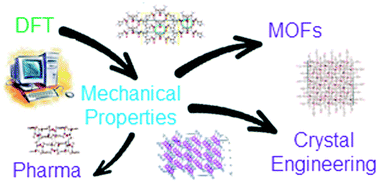
CrystEngComm, 2021,23, 5697-5710
https://doi.org/10.1039/D1CE00453K
Dynamic effects in crystalline coordination polymers
Dynamic macroscopic behaviour of single crystals of coordination polymers when subjected to light, heat, and mechanical force.
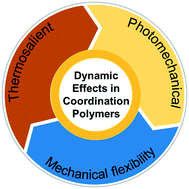
CrystEngComm, 2021,23, 5738-5752
https://doi.org/10.1039/D1CE00441G
Determining the mechanisms of deformation in flexible crystals using micro-focus X-ray diffraction
A newly developed methodology allows for the determination of the mechanisms of deformation in flexible crystals with atomic precision. With broader applications, mapping experiments have wide reaching potential within the field of materials science.
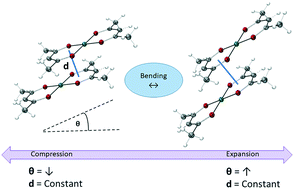
CrystEngComm, 2021,23, 5731-5737
https://doi.org/10.1039/D1CE00401H
Functional flexible molecular crystals: intrinsic and mechanoresponsive properties
Flexible molecular crystals have attracted much attention to unique optoelectronic applications and stimuli-responsive chemistry, resulting in various functional molecular crystals for controlling photons, phonons, electrons, and magnons.
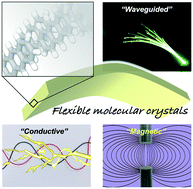
CrystEngComm, 2021,23, 5686-5696
https://doi.org/10.1039/D1CE00388G
Potential and challenges of engineering mechanically flexible molecular crystals
Crystal adaptronics has undergone tremendous developments that have been utilized to rationalize dynamics in crystals. This highlight discusses about the role of intermolecular interactions in rationalizing mechanical responses in crystals.
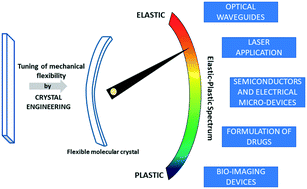
CrystEngComm, 2021,23, 5711-5730
https://doi.org/10.1039/D1CE00173F
Mechanophotonic aspects of a room temperature phosphorescent flexible organic microcrystal
A novel crystal of PTX-2CF3 exhibits room temperature phosphorescence and mechanical flexibility. This flexible crystal efficiently transduces optical emission both in the straight and bent geometries.
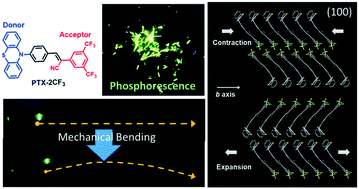
CrystEngComm, 2021,23, 5774-5779
https://doi.org/10.1039/D1CE00475A
Two isomeric zeolite-like metal–organic frameworks with mechanically responsive luminescence emission and gas adsorption properties
The two isomeric zeolite-like metal–organic frameworks based on tetrahedral TPO3− ligands and tetrahedrally connected Cd2+ ions were prepared. One of the compounds shows mechanic-responsive luminescence after the crystals were ground for different time.
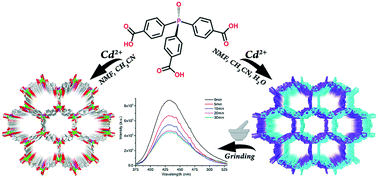
CrystEngComm, 2021,23, 5753-5757
https://doi.org/10.1039/D1CE00464F
Understanding the elastic bending mechanism in a 9,10-anthraquinone crystal through thermal expansion study
Thermal expansion study has been used to understand the mechanism of elastic bending in 9,10-anthraquinone. Expansion along the bending axis due to bending is expected to resemble the thermal expansion along the same direction.
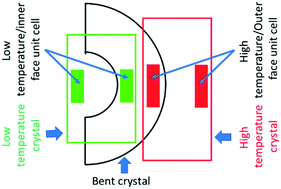
CrystEngComm, 2021,23, 5768-5773
https://doi.org/10.1039/D1CE00467K
Curving deformation-induced photoluminescence changes and anisotropy analysis in elastic organic crystals
Mechanical deformation-induced physical property changes of elastically flexible molecular crystals were successfully investigated by spatially resolved μ-photoluminescence (PL) spectroscopy for the PL analysis at both the outer and inner sides.
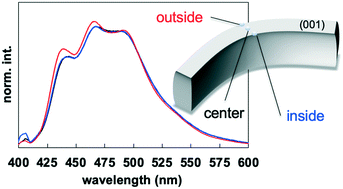
CrystEngComm, 2021,23, 5763-5767
https://doi.org/10.1039/D1CE00400J
Intense red emissive organic crystals with elastic bending ability and optical waveguiding behaviour
Orange (Cry-1O) and red (Cry-1R) emissive crystals were obtained based on a green emissive molecule 1. The light transducing capability of Cry-1R in both the straight and bent states can be applied as an active optical waveguiding medium.
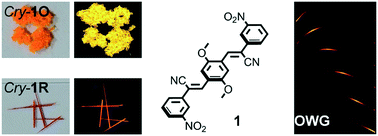
CrystEngComm, 2021,23, 5758-5762
https://doi.org/10.1039/D1CE00192B
Effect of halogen substitution on energies and dynamics of reversible photomechanical crystals based on 9-anthracenecarboxylic acid
A combined experimental/computational analysis of photomechanical anthracene derivatives reveals their kinetic behavior is not simply related to the monomer-photodimer energetics.
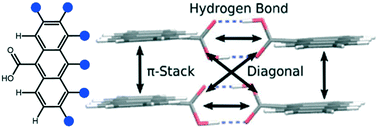
CrystEngComm, 2021,23, 5931-5943
https://doi.org/10.1039/D1CE00846C
Tuning the mechanical flexibility of organic molecular crystals by polymorphism for flexible optical waveguides
The ability to selectively tune the optical and the mechanical properties of organic molecular crystals offers a promising approach towards developing flexible optical devices.
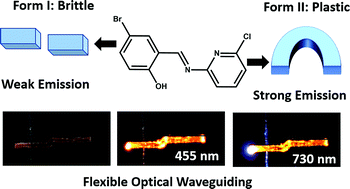
CrystEngComm, 2021,23, 5815-5825
https://doi.org/10.1039/D1CE00642H
Elastic anisotropy of mechanically responsive molecular solids
Unique mechanical properties in molecular solids arise from a specific combination of structure and interaction anisotropy. Powder Brillouin light scattering offers new insight into the latter contribution to test current models for mechanical design.
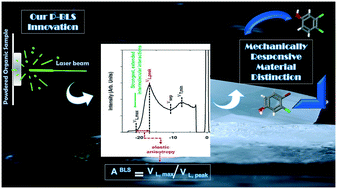
CrystEngComm, 2021,23, 5805-5814
https://doi.org/10.1039/D1CE00542A
A high contrast mechanochromic luminescent diacetylene-linked bis-benzothiadiazole derivative
A rod-shaped self-assembling diacetylene-linked bis-benzothiadiazole derivative presents a high contrast luminescence phase transformation upon shearing which is reversed upon heating.
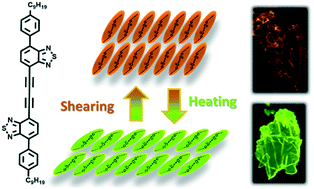
CrystEngComm, 2021,23, 5925-5930
https://doi.org/10.1039/D1CE00462J
Further investigations of the crystal-to-crystal phase transition of a [2]pseudorotaxane composed of ferrocene-terminated dialkylammonium and dibenzo[24]crown-8-ether
A pseudorotaxane with different or mixed counter anions undergoes thermal phase transition, which is related to the interaction between the counter anion and macrocyclic component.
![Graphical abstract: Further investigations of the crystal-to-crystal phase transition of a [2]pseudorotaxane composed of ferrocene-terminated dialkylammonium and dibenzo[24]crown-8-ether](/en/Image/Get?imageInfo.ImageType=GA&imageInfo.ImageIdentifier.ManuscriptID=D1CE00457C&imageInfo.ImageIdentifier.Year=2021)
CrystEngComm, 2021,23, 5944-5952
https://doi.org/10.1039/D1CE00457C
Effect of dehydration pathway on the surface properties of molecular crystals
Atomic force microscopy was used to determine roughness, elastic modulus and work function after thermally-induced and solvent-induced dehydration. These properties correlated with electric charging to provide insight into behaviour of bulk powders.
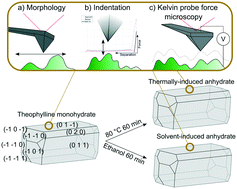
CrystEngComm, 2021,23, 5788-5794
https://doi.org/10.1039/D1CE00539A
Supramolecular complex strategy for pure organic multi-color luminescent materials and stimuli-responsive luminescence switching
Pure organic multi-color luminescent materials were finely tuned from blue through green to red using a supramolecular complex strategy, exhibiting force- and solvent-sensitive luminescence switching in the stimuli-responsive field.
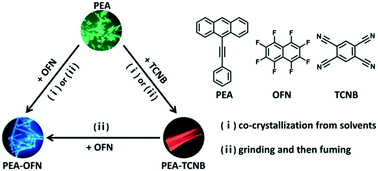
CrystEngComm, 2021,23, 5918-5924
https://doi.org/10.1039/D1CE00449B
Multi-color mechanochromic luminescence of three polymorphic crystals of a donor–acceptor-type benzothiadiazole derivative
The three polymorphic crystals of a donor–acceptor dye exhibited different luminescence colors, which changed in response to mechanical grinding.
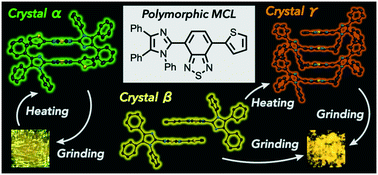
CrystEngComm, 2021,23, 5899-5907
https://doi.org/10.1039/D1CE00445J
Elastic deformability and luminescence of crystals of polyhalogenated platinum(II)–bipyridine complexes
A series of polyhalogenated platinum(II)–bipyridine complexes showed solvent-of-crystallisation-dependent elastic flexibility and luminescence.

CrystEngComm, 2021,23, 5891-5898
https://doi.org/10.1039/D1CE00459J
The design of dihalogenated TPE monoboronate complexes as mechanofluorochromic crystals
Mechanofluorochromic crystals based on tetraphenylethylene and boronates reversibly change their emission upon grinding, setting the path to develop bistable switches in the future.
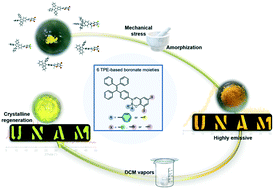
CrystEngComm, 2021,23, 5908-5917
https://doi.org/10.1039/D1CE00442E
Chlorinated diketopyrrolopyrrole dye exhibits a three-step polymorphic transition with thermosalient effects
A diketopyrrolopyrrole dye was found to exhibit a three-step polymorphic transition by heating with thermosalient effects.
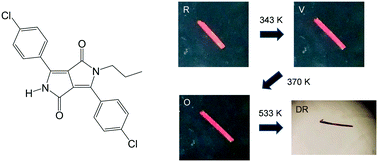
CrystEngComm, 2021,23, 5882-5890
https://doi.org/10.1039/D1CE00454A
Photoinduced topographical surface changes and photoresponse of the crystals of 7-methoxycoumarin
Photoinduced topographical changes, bending, and photosalient effect due to the dimerization reaction were observed on a single crystal of 7-methoxycoumarin, upon deep UV (254 nm) light irradiation.
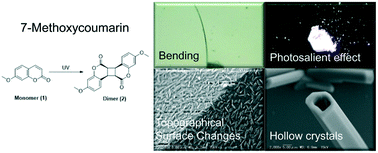
CrystEngComm, 2021,23, 5780-5787
https://doi.org/10.1039/D1CE00444A
Mechano-induced photoluminescence colour change in an alkyltolane-terminated cyanostilbene
A novel alkyltolane-terminated cyanostilbene is synthesized. The photoluminescence colour changed depending on the precipitation method, with either a red shift or blue shift in the photoluminescence spectra observed upon mechanical grinding.
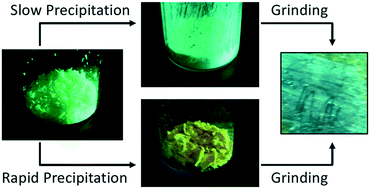
CrystEngComm, 2021,23, 5869-5875
https://doi.org/10.1039/D1CE00456E
Light-fueled rapid macroscopic motion of a green fluorescent organic crystal
We report here a new green fluorescent organic crystal of an amide functionalized acrylonitrile derivative (E-ArF2) that displays various types of macroscopic response when illuminated with UV light (390 nm).
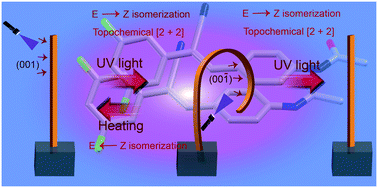
CrystEngComm, 2021,23, 5876-5881
https://doi.org/10.1039/D1CE00460C
A photoluminescent organosuperelastic crystal of 7-amino-4-methylcoumarin
A unique mechanical property of superelasticity is observed not only in so-called shape-memory alloys but also in molecular crystals.
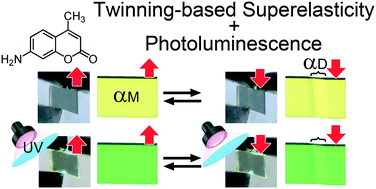
CrystEngComm, 2021,23, 5801-5804
https://doi.org/10.1039/D1CE00359C
Fluorine as a robust balancer for tuning the reactivity of topo-photoreactions of chalcones and the photomechanical effects of molecular crystals
The higher the number of fluorine atoms, the higher the topological photo-induced [2 + 2] cycloaddition reactivity of chalcones.
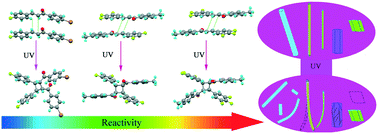
CrystEngComm, 2021,23, 5856-5868
https://doi.org/10.1039/D1CE00086A
Actuation performance of a photo-bending crystal modeled by machine learning-based regression
The bending deflection and blocking force of photo-bending crystals of different sizes were experimentally measured at various light intensities, and then modeled by the machine learning-based regression.
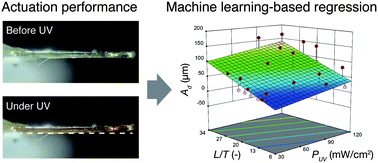
CrystEngComm, 2021,23, 5839-5847
https://doi.org/10.1039/D1CE00208B
Epimers with distinct mechanical behaviours
Two epimeric series of esters exhibit distinct mechanical behaviour: brittle crystals for one series and ductile crystals for the other series.
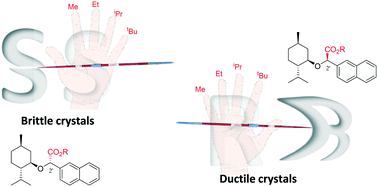
CrystEngComm, 2021,23, 5848-5855
https://doi.org/10.1039/D0CE01723J
Probing anisotropic mechanical behaviour in carbamazepine form III
Nanoindentation measurements in single crystals of carbamazepine form III show that the (020) face is stiffer and harder than the (002) and (101) faces. AFM imaging and molecular simulations reveal that the (020) plane is the most likely slip plane.
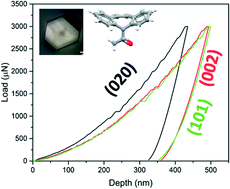
CrystEngComm, 2021,23, 5826-5838
https://doi.org/10.1039/D0CE01659D
Anisotropic bending and twisting behaviour of a twin crystal composed of a diarylethene
The unusual photomechanical behaviour of a “twin crystal” consisting of a diarylethene derivative was investigated.
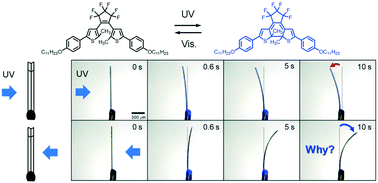
CrystEngComm, 2021,23, 5795-5800
https://doi.org/10.1039/D0CE01705A
About this collection
This themed issue, guest edited by Advisory Board member, Changquan Calvin Sun, and Associate Editor, C Malla Reddy, includes articles on various types of mechanically responsive crystalline materials. While the design principles are still evolving, a great progress has been made in recent years in understanding the structure-mechanical property correlation in molecular crystals. Majority of the articles in this issue cover crystals that respond to either mechanical stress, light and/or heat. Characterization tools, such as nanoindentation, spatially resolved X-ray diffraction, Brillouin light scattering, and computational techniques, have gained prominence in studying the mechanical properties of crystalline materials. Articles on optical properties of mechanically responsive crystals not only reveal the strong structure-property correlation but also present the new opportunities for designing functional materials through crystal engineering